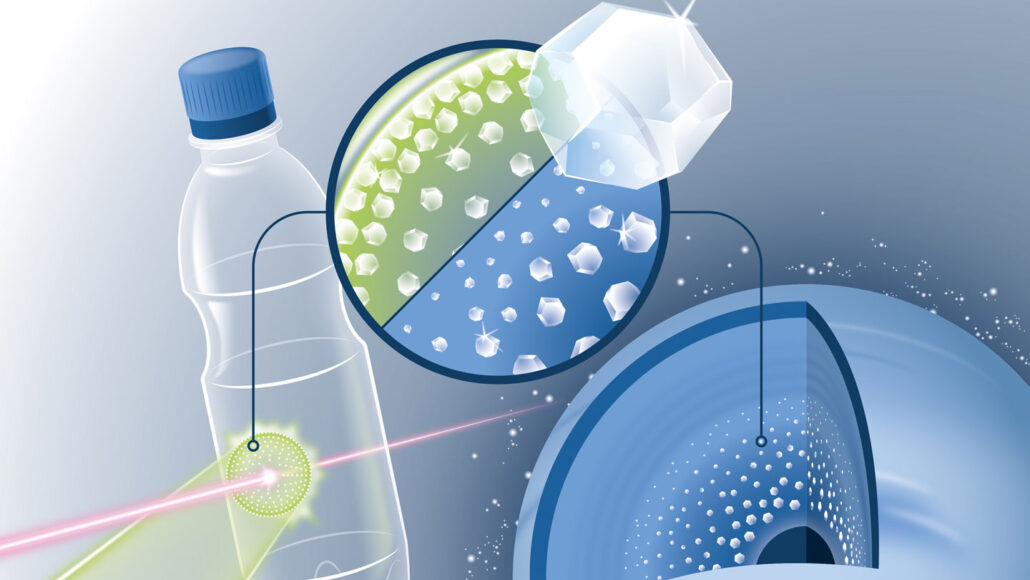atmospheric pressure: The pressure exerted by the weight of the atmosphere.
chemical: A substance formed from two or more atoms that unite (bond) in a fixed proportion and structure. For example, water is a chemical made when two hydrogen atoms bond to one oxygen atom. Its chemical formula is H2O.
compound: (often used as a synonym for chemical) A compound is a substance formed when two or more chemical elements unite (bond) in fixed proportions. For example, water is a compound made of two hydrogen atoms bonded to one oxygen atom. Its chemical symbol is H2O.
crystal: (adj. crystalline) A solid consisting of a symmetrical, ordered, three-dimensional arrangement of atoms or molecules. It’s the organized structure taken by most minerals. Apatite, for example, forms six-sided crystals. The mineral crystals that make up rock are usually too small to be seen with the unaided eye.
diamond: One of the hardest known substances and rarest gems on Earth. Diamonds form deep within the planet when carbon is compressed under incredibly strong pressure.
forge: (verb) To shape metals under heat and/or pressure, or (colloquially) to form one element from another under the intense heat and pressure inside stars.
hydrogen: The lightest element in the universe. As a gas, it is colorless, odorless and highly flammable. It’s an integral part of many fuels, fats and chemicals that make up living tissues. It’s made of a single proton (which serves as its nucleus) orbited by a single electron.
insight: The ability to gain an accurate and deep understanding of a situation just by thinking about it, instead of working out a solution through experimentation.
laser: A device that generates an intense beam of coherent light of a single color. Lasers are used in drilling and cutting, alignment and guidance, in data storage and in surgery.
literally: An adjective indicating that the phrase it modifies is precisely true. For instance, to say: "It's so cold that I'm literally dying," means that this person actually expects to soon be dead, the result of getting too cold.
molecule: An electrically neutral group of atoms that represents the smallest possible amount of a chemical compound. Molecules can be made of single types of atoms or of different types. For example, the oxygen in the air is made of two oxygen atoms (O2), but water is made of two hydrogen atoms and one oxygen atom (H2O).
oxygen: A gas that makes up about 21 percent of Earth's atmosphere. All animals and many microorganisms need oxygen to fuel their growth (and metabolism).
PET: Short for polyethylene terephthalate. It's a commonly used plastic that can be produced as strong, stable fibers for use in making fabric. It also is the basis of many plastic beverage bottles (such as milk jugs) and semi-hard food packages (often used for produce). When used in fabrics, it’s simply known as polyester. To identify these plastics in goods other than clothing, they tend to carry a label on the bottom or side with the number 1 surrounded by the triangular "chasing arrows" symbol and the acronym PET or PETE below the triangle.
physicist: A scientist who studies the nature and properties of matter and energy.
planet: A large celestial object that orbits a star but unlike a star does not generate any visible light.
plastic: Any of a series of materials that are easily deformable; or synthetic materials that have been made from polymers (long strings of some building-block molecule) that tend to be lightweight, inexpensive and resistant to degradation.
pressure: Force applied uniformly over a surface, measured as force per unit of area.
quantum: (pl. quanta) A term that refers to the smallest amount of anything, especially of energy or subatomic mass.
wave: A disturbance or variation that travels through space and matter in a regular, oscillating fashion.
X-ray: A type of radiation analogous to gamma rays, but having somewhat lower energy.








